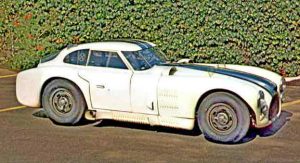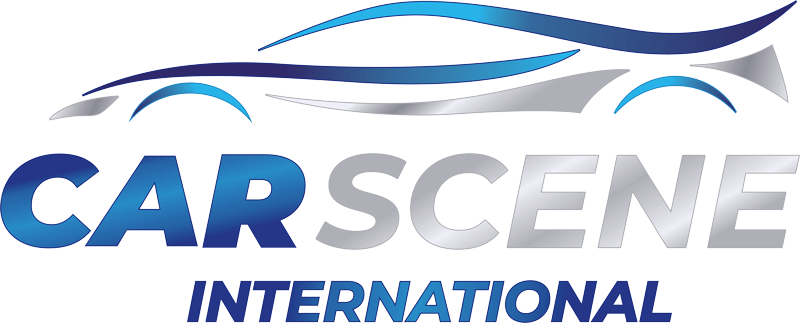 Healey and other fine cars News BulletinAs regular readers of the Healey Bulletin wil know, when I launched the Bulletin, in October 2017, its purpose was to showcase the contents of the Warwick Healey Motor Company archive (WHMCA), owned by the Warwickshire County Record Office (WCRO). Since September 2018 the Bulletin has moved on from its ‘showcasing’ mission to having broader articles featuring both Healey and “other fine cars”. Or, at least that was the plan. In practice I got caught up with the wonderful (i.m.o.) ‘Oral History’ transcripts. I have published three so far and there is another one, featuring ‘John DeLorean’ (no! he didn’t record the interview but someone who worked with him and had connections with Donald and Geoff Healey, did) in the pipeline. However, in the meantime, Chuck Huber (aka Rocky USA) has come to the party again with some photos taken at his pad in Arizona U.S. featuring some exotic automotive machinery including a Cunningham C4R*. One thing led to another and I found myself introduced to Chuck’s friend Larry Pfitzenmaier who owns the Cunningham. *In fact it is not a C4R but a C4RC the last ‘C’ standing for ‘Continuation’. Philistines might want to refer to it as a ‘Replica’ but doing so would being paying a great diservice to how the ‘Contiuation’ project was conceived and executed, as you will read in the following article. I had already written about Healey’s connection with Cunningham in Healey Bulletin II and I had developed this story in an article I produced for the AHC of America’s ‘Healey-Marque’ magazine earlier this year. I sent Larry a copy of that article and in turn he provided me with some fascinating information concerning the Cunningham 4R Continuation cars. I am now taking the opportunity of welding these stories together, inspired by Briggs Cunningham’s concept of putting a Cadillac V-8 engine in a Healey Silverstone chassis. Healey – Cunningham – Cadillac Here are a couple of intriguing photos taken from the Warwickshire County Record Office’s Healey Motor Company archive. They are of a Healey Silverstone fitted with a Cadillac 331cu.in. OHV V8 engine. The location is a workshop in the Donald Healey Motor Company Cape works, Warwick. It was Briggs Cunningham who first fitted a Cadillac V8 engine into a Healey Silverstone. I have read that he ordered two Silverstones from the DHMCo., one a standard car with the Riley engine and the other as a rolling chassis. It was, of course, the latter into which the Cadillac engine was fitted. This car was raced with success in club events in the States during the early 1950s. This led to Cunningham building his first production series car, the C3 ‘Continental’ with body by Carrozzeria Alfredo Vignale of Milan, Italy. (see photo at the end of the article). DMH was interested in fitting Cadillac engines to his cars hence the famous voyage to the U.S., in December 1949, with the objective of trying to procure said engines from Cadillac. It was on that voyage, aboad Cunard’s Queen Elizabeth ocean liner, that he bumped into George Mason, C.E.O. of the Nash Kelvinator Corp., this, in turn, led to the Nash-Healey car being created. Incidentally, some Post War Jensens were also fitted with Nash engines, but that is another story.   The Cunningham 4R Continuation project as told by Larry Pfitzenmaier  Larry Black had been excited about all things Cunningham since the day his dad gave him a model of an early Cunningham race car. Growing older, his life moved in other directions, but his passion for Cunningham cars and the larger Cunningham story never diminished. In 1993, while living in Seattle, Larry decided that the time had come to seriously consider building a C4R recreation. But not simply a plastic “look-alike” or kit car. Larry’s vision was to duplicate the original car with exacting precision and correct materials, and, if possible, to work with the Cunningham family to deliver a small number of turn-key C4R Continuation cars with a direct link to the former B.S. Cunningham Company and the glory days of the Cunningham racing team. Beyond the substantial challenge of establishing a program to build C4R Continuation cars, Larry’s larger goal was to use those cars to introduce a new generation of enthusiasts to the Cunningham name and fame which would be followed by the introduction of a new, state-of-the-art Cunningham V-12 grand touring car capable of competing at all levels with the most respected high-performance automobiles in the world. This new “supercar” would incorporate styling features recalling the C4RK, the car Larry had always considered to be the most visually exciting car on the planet, a view shared by many enthusiasts to this day.  Larry established a financial partnership with Steve Norman, owner of the BMW dealership in downtown Seattle, assembled a small team of craftsmen and fabricators and, using photos from many sources, expanded modeling techniques, and an “artist’s eye”, began construction of his C4R recreation. Not wanting to proceed further without the endorsement of the Cunningham family, Larry arranged, through Cunningham friend, journalist, and former Cunningham team driver, Denise McCluggage, to meet in October 1994 with Briggs Cunningham’s son, Briggs III, and other Cunningham family members at Seattle International Raceway to display and demonstrate his C4R recreation. Although certainly still “rough-around-the-edges”, Larry’s recreation, driven by Briggs III and professional race drivers McCluggage and Brian Cunningham, performed well, justifying further development and testing.  Largely motivated by the opportunity to honour his father and to introduce the Cunningham legacy to a new generation of enthusiasts, Briggs III agreed to buy Norman’s financial position, to reestablish The Cunningham Company, to employ Black as Managing Director, to move the enterprise from Seattle to Lime Rock, Connecticut, to complete the development and testing of Larry’s C4R recreation (now recognized as the prototype Continuation car, or C4RC) and to establish a very-low-rate C4RC production capability. These “Continuation” cars would be legitimate Cunningham C4Rs, endorsed by the Cunningham family and built by The Cunningham Company, but obviously lacking the historic context of the original 1952 cars. Additionally, at the outset, Briggs III shared Larry’s vision of using the C4RC program as a stepping-stone to the larger goal of launching a modern grand touring car with styling and performance reflecting the tradition of the C4RK. Concept development and planning associated with this future Cunningham, later to be known as the C-7, were pursued in parallel with the development and marketing of the C4RC cars. Upon arrival at Lime Rock, the frame and chassis of the prototype C4RC were well sorted, but much work remained to refine and complete the correct shaping of body contours and the final assembly of trim components. This process was later updated to be far less labor intensive by using digital scanning techniques to replicate the contours of one of the original C4R cars. By July 1997 the completed prototype C4RC was undergoing final track testing, driven frequently by John Fitch and Phil Walters, the latter being in many respects the “father” of the original 1952 C4R cars and without doubt one of the most competent race car drivers of his era. The final configuration of the C4RC cars deviated in several respects from the original 1952 cars, which themselves were not identical. These deviations were made to achieve a fundamental goal of delivering a car whose appearance and dynamics are period-correct, but with a nod to safety and drivability. All C4RC cars are powered by 1952 Chrysler 331 cu. in. “extended block” hemi-head engines configured with four dual-throat downdraft Weber carburetors. Per customer preference, engines were delivered in various states of tune. This engine and carburetor application is an accurate duplication of one of several original C4R configurations. Although a quantity of vintage Siata transmissions, as originally used in 1952, had been located, all C4RC cars were delivered with New Process (Chrysler) A-833 four-speed gearboxes. Likewise, original drum brakes were offered, but all C4RC customers requested delivery with Wilwood ventilated discs. Fabricated front A-arms are used rather than the stock 1952 Lincoln A-arms. Steering is via rack-and-pinion rather than the original Dodge steering box. The rear suspension of the prototype C4RC incorporates a Halibrand quick-change rear end which was useful during testing when optimizing the final drive ratio. The production C4RC cars incorporate a Dodge 8.75 inch truck axle, narrowed to a 54-inch track and located by equal-length upper and lower trailing arms, as per the original 1952 cars. In keeping with the plan to continue the original 1952 C4R serialization format, the prototype C4RC was often referred to as R5219, the next number in the sequence. That number, however, did not appear on the prototype identification plate, which simply identified the car as “Prototype” and included the engine number. From late 1997 until 2001, the completed prototype was photographed, driven, used and abused by dozens of automotive journalists and enthusiasts. Their comments were, with few exceptions, most favorable, receiving feature coverage in many national and international automotive periodicals. Four Cunningham C4RC cars were built, including the prototype. The first production car, R5220, was sold to Bob Williams, a former owner of an original 1952 C4R. The second production car, R5221, was sold to Martin Swig in October 2000, then to Peter Hosmer in early 2002. The third production car, R5223, was sold to Bob Lutz in mid-2001. Lastly, the prototype C4RC, originally intended to remain with the Cunningham family, was retired from the “media demo circuit”, refurbished, numbered as R5222, and sold to Terri Henning in late 2001, thus becoming the first C4RC built and the last C4RC – and the last Cunningham – sold. Terri later sold the car to Eric Zausner in March 2004, who in turn sold it to Larry Pfitzenmaier in June 2007. The Cunningham C4RC program was terminated before reaching its full potential for a variety of reasons, including difficulty in maintaining competent and affordable venders, cash flow problems, and business and financial issues related to the still-born C-7 project. Never-the-less, the four completed C4RC cars remain as an exciting and beautiful testimony to one of the greatest sagas in American motorsports. The Cunningham family has stated that it was never their intent to make money on these cars, but rather to create a memorial to the man who originally built and raced them so many years ago. In that they most surely succeeded.   Links – If you want to read more of the Cunningham story visit – http://www.briggscunningham.com ** Photographs marked thus belong to the WCRO – http://heritage.warwickshire.gov.uk/warwickshire-county-record-office/county-record-office-services/county-record-office-copying-services/ |
